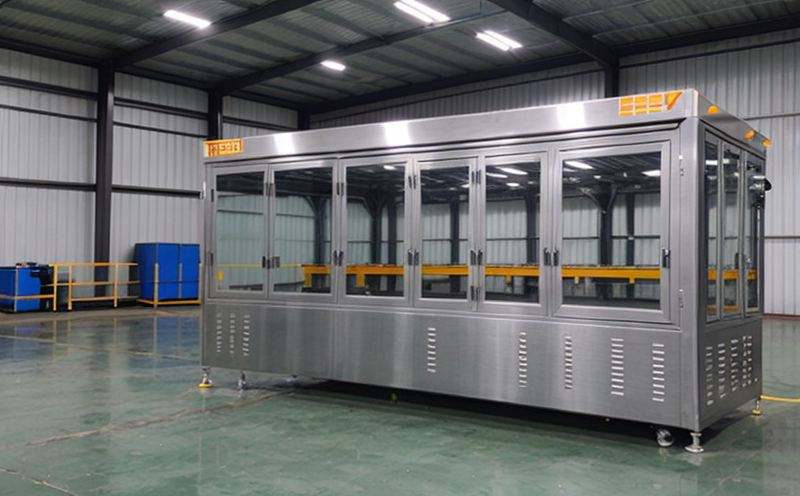ASTM D522 Mandrel Bend Test for Coated Metals
The ASTM D522 Mandrel Bend Test is a critical procedure used to evaluate the ductility and flexibility of coated metal packaging materials. This test method is particularly important in the packaging sector as it provides insights into how well the coating will perform under bending stress, which is crucial for ensuring product safety and quality.
The test involves bending a specimen around a mandrel at specified angles to determine if there are any cracks or separations in the coating. The test is essential because it helps packaging material manufacturers ensure that their products meet the required standards for durability and protection during transport and storage.
During the ASTM D522 Mandrel Bend Test, the specimen must be prepared carefully to ensure accurate results. Typically, specimens are cut from rolls of coated metal in a manner consistent with commercial manufacturing processes. The test requires precise control over temperature, humidity, and other environmental factors that could affect the outcome.
The mandrels used in this test come in various diameters and are chosen based on the thickness of the coating being tested. The angles at which the specimen is bent can also vary depending on the specific application and standards. For instance, a 180-degree bend might be sufficient for some applications while others may require more severe bends to fully assess the material's flexibility.
The test results are analyzed by visually inspecting the specimens for cracks or separations in the coating after bending. The acceptance criteria for this test are stringent and vary depending on industry standards, but generally, coatings should not exhibit any visible signs of damage under the specified conditions.
Understanding the ASTM D522 Mandrel Bend Test is crucial for quality managers and R&D engineers responsible for developing new packaging materials. It allows them to make informed decisions about material selection and process optimization. Compliance officers can use these test results to ensure that their products meet regulatory requirements, thereby safeguarding consumer safety.
The importance of this test extends beyond the lab into real-world applications where coated metal packaging is exposed to bending stresses during handling and shipping. By ensuring that the coating remains intact under these conditions, manufacturers can extend the shelf life and protect the integrity of the packaged products.
Why It Matters
The ASTM D522 Mandrel Bend Test is vital for several reasons. Firstly, it provides a standardized method to assess the flexibility of coated metal packaging materials, which is essential for ensuring product safety and quality during transportation and storage.
Secondly, this test helps manufacturers optimize their production processes by identifying areas where improvements can be made to enhance the durability and performance of their products. By understanding how different coating thicknesses or types perform under bending stress, companies can make data-driven decisions that lead to better outcomes.
Thirdly, compliance with this test is crucial for meeting regulatory requirements set forth by various standards bodies such as ASTM, ISO, and others. Failure to meet these standards could result in product recalls, legal issues, and damage to the company's reputation.
In addition to its role in quality assurance, the ASTM D522 Mandrel Bend Test also plays a significant part in research and development efforts aimed at creating new materials or improving existing ones. Engineers can use the insights gained from this test to innovate and develop products that meet current and future market needs.
The results of this test are not only valuable for internal use but also serve as important documentation when dealing with clients or regulatory bodies. It provides a clear picture of the product's performance, which is critical for building trust and ensuring successful commercialization.
Applied Standards
| Standard | Description |
|---|---|
| ASTM D522-18 | Standard Test Method for Determining the Flexibility of Coated Metals by Mandrel Bend. |
| ISO 6709:1984 | Plastic Film and Sheeting - Determination of Tear Strength. |
| EN 352-1:2000 | Flexible Packaging Materials - Determination of Permeability to Gases. |
| IEC 60068-2-74:2019 | Determination of the resistance of materials to repeated mechanical bending stress. |
Why Choose This Test
The ASTM D522 Mandrel Bend Test offers several advantages that make it an ideal choice for evaluating coated metal packaging materials. One of the primary benefits is its ability to provide a standardized and reliable method for assessing material flexibility, which is crucial for ensuring product safety and quality.
Another advantage is its versatility; this test can be adapted to suit different coating types and thicknesses, making it suitable for various applications within the packaging sector. This adaptability ensures that manufacturers can tailor their testing procedures to meet specific industry needs.
The test also helps in optimizing production processes by highlighting areas where improvements are needed. By identifying weaknesses early on, companies can implement changes that lead to better outcomes and ultimately enhance customer satisfaction.
Furthermore, compliance with this test is essential for meeting regulatory requirements set forth by various standards bodies such as ASTM, ISO, and others. This ensures that products are safe and meet the necessary quality standards, reducing the risk of product recalls or legal issues.
The insights gained from the ASTM D522 Mandrel Bend Test also play a significant role in research and development efforts aimed at creating new materials or improving existing ones. Engineers can use these findings to innovate and develop products that meet current and future market needs, thereby gaining a competitive edge in the industry.
The results of this test serve as important documentation when dealing with clients or regulatory bodies, providing a clear picture of the product's performance. This transparency fosters trust and ensures successful commercialization, ultimately benefiting both manufacturers and consumers alike.





